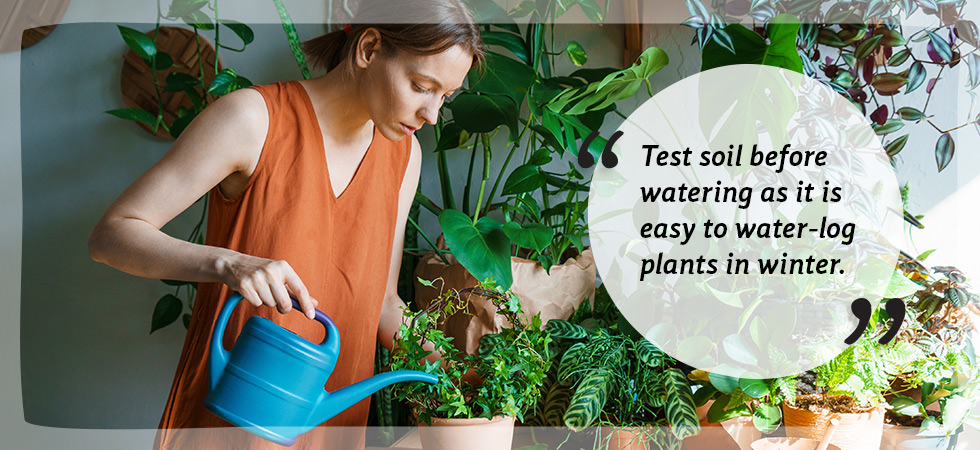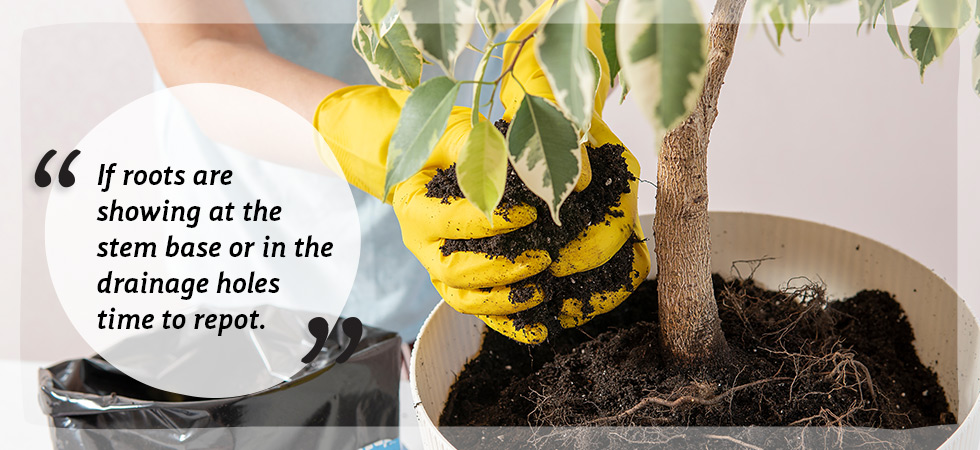How to care for houseplants this winter
Having plants around us helps our health. It’s why NASA takes them on its space flights after all! But how do you return the favour? We’ve lots of tips on how to care for houseplants this winter so they survive and thrive.

Watering winter houseplants
Many houseplants are dormant in the winter months. As they’re not putting on new growth, they don’t need as much water. Usually watering once a fortnight is fine, sometimes even less.
Over-watering can be just as harmful as under-watering. Soggy soil can damage roots, and they may start to rot. Make sure to test the soil in the pot first. Don’t want to use your fingers? Push a pencil down into the compost. If some granules stick to it, your plant doesn’t need watering.
Pro tip: Using a water mister is the perfect way to keep your houseplants happy, especially given how central heating can dry out air during the winter.
How to keep houseplants warm
On a sunny winter’s day, surely there’s nowhere better for plants than a windowsill? But before you squeeze all your pots on there, check the temperature first – most houseplants like to be in temperatures of at least 16C. Also can you solemnly swear to always move them back into the warmth when it gets dark?
Heating from above or below is a sound bet for houseplant health. You can use a heating lamp or mat which will also come in handy when propagating new plants next spring. A low-cost version is to swaddle the pots in fabric or bubble wrap to keep in the heat. Or you could add a heater to the space. But houseplants don’t like any kind of draft – especially extremely hot or cold. So position them away from any blasts of air.
Don’t forget to dust those leaves! That way, your houseplants have more chance of absorbing sunlight to photosynthesise and create energy from sunlight.
While we’re on the subject of sunlight, do you want your houseplants to grow evenly? Then rotate them a smidge every few weeks. If you’ve lots of plants, maybe invest in a Lazy Susan stand to save time.
Repotting houseplants in winter
Before you start, does your plant like to be in a small pot? Bird of Paradise plants and peace lilies are more likely to flower if they’re not putting their energy into growing more roots.

Best time to repot a houseplant?
Ideally you should repot houseplants when spring is just around the corner. This is because sometimes repotting leads to a growth spurt. This may sound like a positive. But not when there isn’t enough sunlight to maintain the new growth.
Another reason to delay repotting is transplant shock. Plants need to root well in order to survive. But in winter, plants are on a ‘go-slow’ so may not be able to develop a good enough root system in their new growing medium. And never repot if the plant is flowering!
When should you repot in winter?
Are roots showing through drainage holes? Unless you do something, the roots will eventually suffocate the plant. Make sure to rough up the roots a little to help break them up, before repotting.
If you received a plant as a present, re-potting is a good idea. Especially if the plant has been gifted in a pot without drainage holes. No drainage = rotting plants. Also shop-bought plants often don’t have the best quality compost.
Mouldy soil on the pot’s surface means you should repot the plant. Make sure you thoroughly wash out the container too if you want to re-use it elsewhere.
Is the plant tipping over in the pot? This may be caused by too many roots in too small a space drying out the soil.
What you need to repot
• A clear surface to work on, and you don’t mind getting dirty. Lay down some newspaper to protect the surface.
• A clean pot 5cm wider than the old pot. It’s tempting to go big to save potting on again, but too large a pot can trigger transplant shock
• A pair of scissors in case you have to cut the plant out of a plastic pot or a hammer if you need to break open a pot.
• Fresh compost – peat-free coir is a great choice. One of our compressed 5kg Coco Grow brick provides 75 litres of coconut coir growing medium when you add water. Need less? Just break off a little at a time, add water and fluff it up.
• Patience in removing the plant. Be gentle and take it slowly. Cut and break off any roots which are preventing you from taking the pot off. There are lots more great tips in the Repotting Your Indoor Plants guide
How do mulch mats work?
Mulching is a gardening term for adding a protective layer on top of the soil. It’s a great way to keep plants at a constant temperature, boost drainage and retain water.
When used indoors, it can help avoid ‘soil splash’ on lower leaves, discourage pests from laying eggs in the pot’s soil as well as other unwelcome attention. Do you have pets who like to dig? Toddlers, who like to make mud pies? Then you know how soon things can go pear-shaped around houseplants.
Add neutral texture and a rainforest vibe
Our 100% natural coir mulch mats are an incredibly easy and neat way to protect your houseplants. You just place the coir disc around the bottom of your plant’s stem.
Mulch mats also give a consistent look to the top of pots, which looks pretty smart!
Tips from the ‘Green Gardeners Guild’ online advice library
Get more tips and hints on improving your green fingers by checking out our blogs:
• How to prepare coco coir: garden use vs indoor plants
• Winter gardening: a guide
• How to keep plants warm in winter
A winter wonderland of houseplants?
Do you have fantastic ferns? A colossal cactus? Let us know on social media! Please post your pictures and tag in @cocoandcoir on Instagram. We’ll credit you for any images we use and you’ll even get £10-worth of loyalty points for any of your stories we use!










